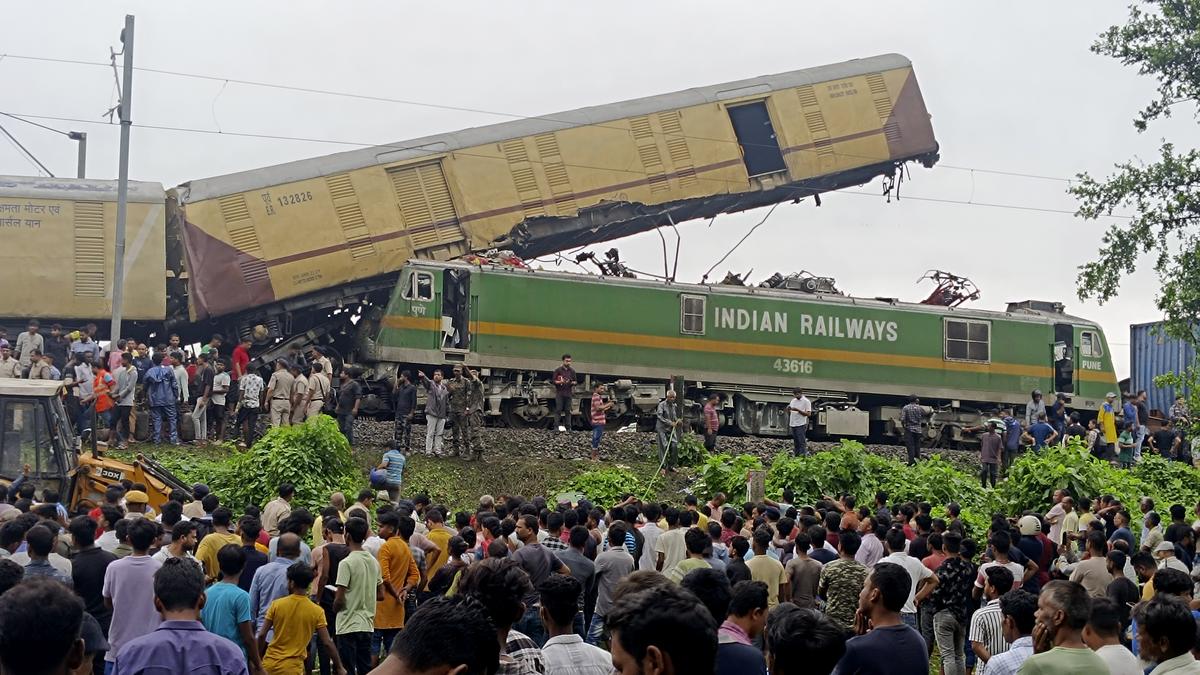
What can the Railways do to stop accidents? | Explained Premium
The Hindu
Train accident near New Jalpaiguri in West Bengal caused by human error, lack of safety measures, and systemic failures.
The story so far: On June 17, a train accident killed 10 people and injured over 40 near New Jalpaiguri in West Bengal, about 600 km from Kolkata. The mishap was caused when a goods train hit the 13174 Down Agartala Sealdah Kanchanjunga Express in the rear at 8.55 a.m. The two trains were manually cleared to run in the same block section, a mere 15 minutes apart, since automatic signalling was malfunctioning between the Ranipatra and Chattar Hat stations which fall under the Northeast Frontier Railway.
The Railway Board initially said the prima facie cause of the accident was that the loco pilot of the GFCJ container train (goods train), who died in the accident, disregarded the Railways’ General and Subsidiary Rules (G&SR) and proceeded at normal speed which led to the collision with the Kanchanjunga Express. The Railways has ordered a statutory inquiry.
The Railway Board initially blamed the loco pilot of the goods train; this was later rescinded, but the damage had already been done. It is impossible to operate a train across a block section on the instruction of one person; there’s a chain of command and a list of procedures that need to be followed. For instance, the station masters of stations between which a train is running, the section controller (who is stationed at the divisional headquarters and monitors all rake movements), the signal staff and the gatemen between the stations have to be informed in a particular manner, and a line clearance obtained before a train leaves a station. If there is a discrepancy — like an automatic signal failure, for example — it has to be immediately escalated. In this case, the Katihar division (where the accident occurred) Railway Manager Surendra Kumar stated on record that the gateman had informed Rangapani station about the goods train on the same track as the Kanchanjunga Express. An inquiry will take into consideration this statement, and explore who all were privy to this information. While the inquiry will establish the shortcomings which led to the accident, the Railways has often been seen to take action against lower level staff, while officers at higher levels have gone scot-free after accidents.
In a paper, ‘Analysis Report by High Level Safety Review Committee,’ (2017), Mukesh Mehrotra, a chief signal engineer, noted that only 3% of the accidents in Indian Railways are due to “failure of equipment.” During signal failure, trains can be operated under caution. The station master issues a TA-912 notice, which authorises loco pilots to cross a signal in red during signal failures, and a ‘line clear’ ticket, under the G&SR. The combination empowers the loco pilot to move forward. In this situation, the rule book says that the “driver shall proceed cautiously, so as to stop short [at] any obstruction.” But if there is no prior indication that a signal is defective and the loco pilot suddenly encounters a red signal (stop sign) when the train is on the move, the loco pilot has to stop at the defective signal for a minute during day time, and for two minutes during night time. After this, the loco pilot is expected to proceed with extreme caution at a speed of 15 kmph. This procedure is not applicable when a ‘line clear’ ticket has been issued. Trains are not detained at wayside stations till the signals are set right. The only rule is that there should be only one train between two block sections at any given point of time. Another train can enter only after this train has left that block section.
Yes. But the much-touted anti-collision device, Kavach, was not installed on this route. Kavach would have slowed down the freight train (it was moving at 45 kmph at the time of accident) as the automatic braking system would have become operational. However, progress on implementation of Kavach has been slow because of lack of vendors. According to the Railway Board, the Kavach system is operational in only 1,500 km. The entire Railways spans nearly 68,000 km.
Railway accidents are rare if one takes this statistic into consideration: a minuscule 0.03 accidents happened per million km in both 2020-21 and 2021-22. But this number becomes infructuous if we consider the fact that there were 34 consequential train accidents in 2021-22 in which nine were killed and 45 injured. In 2022-23, however, there were 48 consequential train accidents. In fact, June 2023 witnessed the worst train accident in about two decades in Balasore, where nearly 300 passengers died.
Human failure is a major reason for accidents. In fact, almost all accidents in the recent past have listed human failure as one of the reasons. This includes the derailment of two passenger trains at Kothavalasa railway station (near Vizianagaram) in 2023; the disastrous accident in Balasore involving the Chennai-bound Coromandel Express, the Bangalore-Howrah Express and a goods train; and the 2018 derailment of the New Farakka Express.











